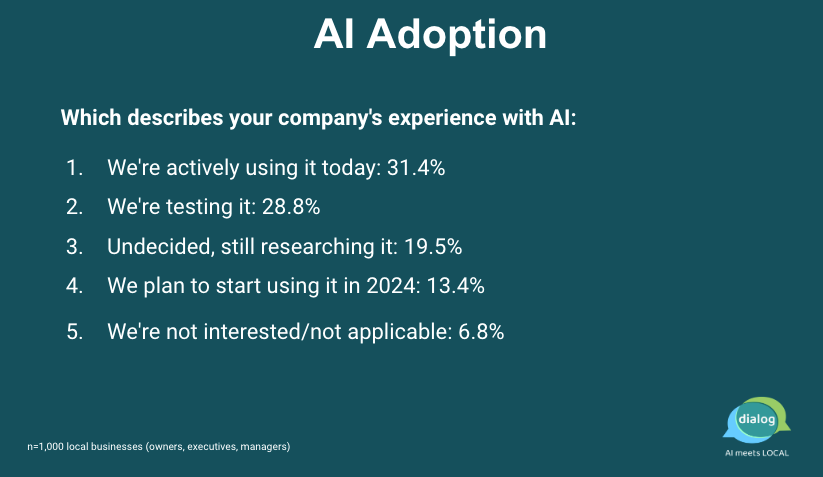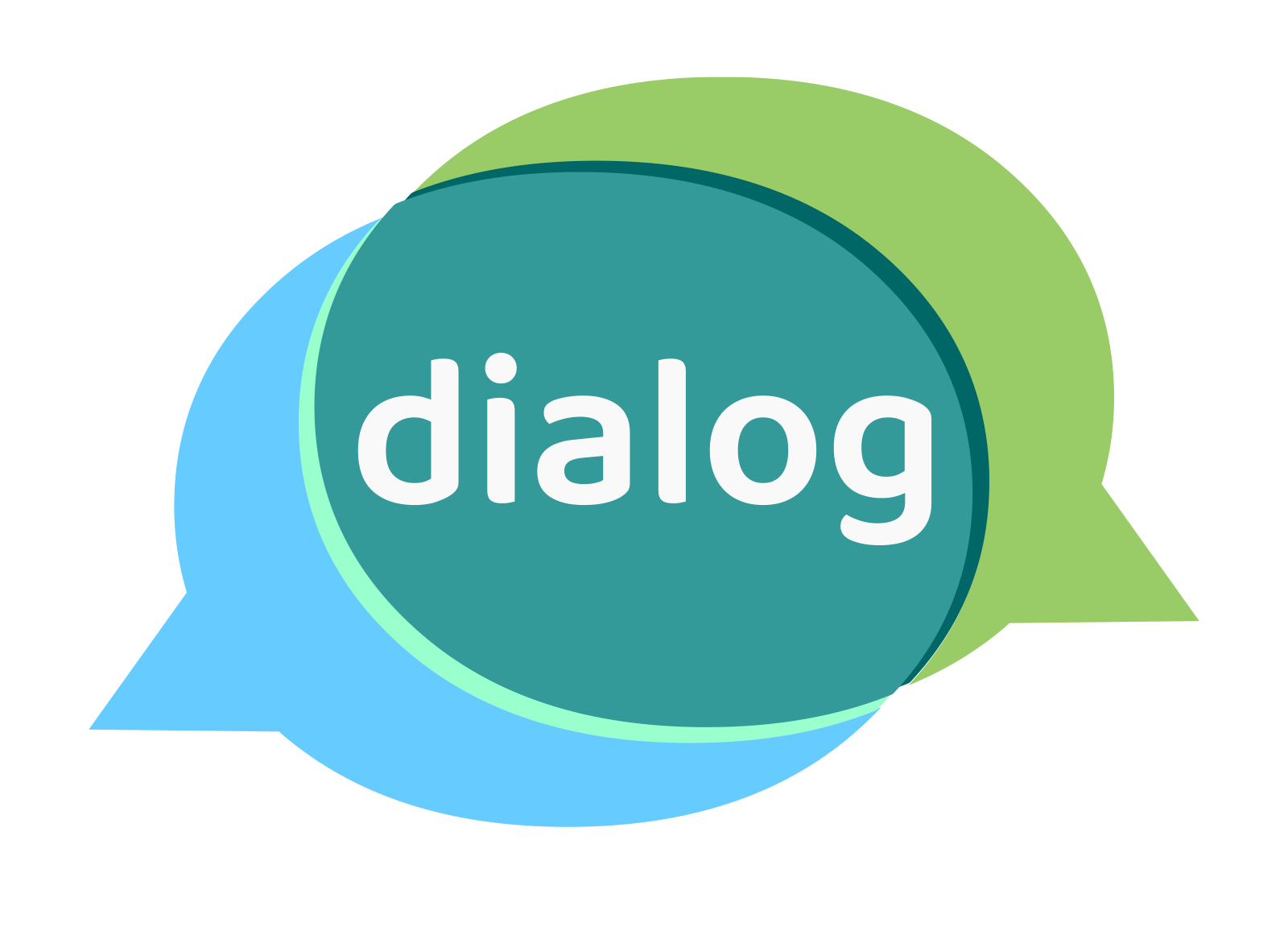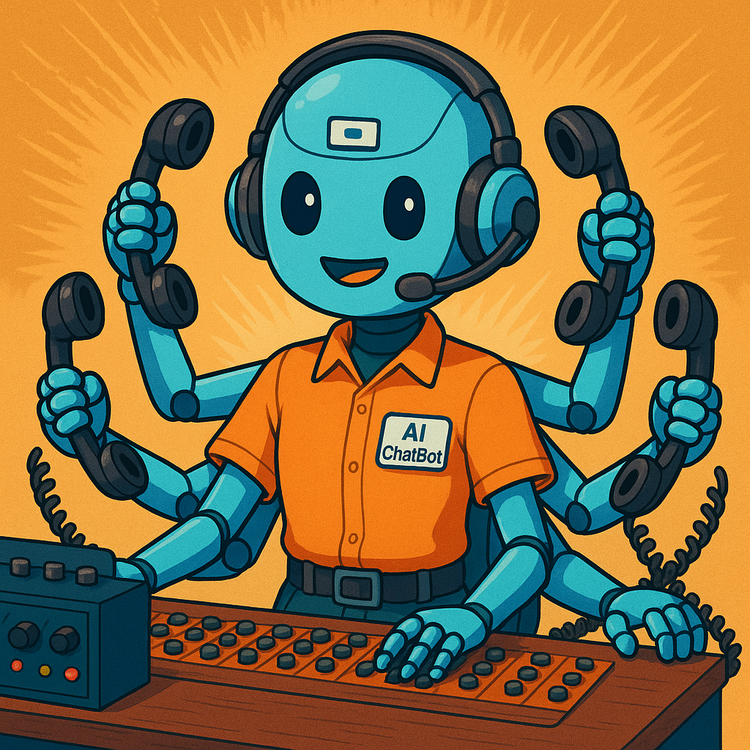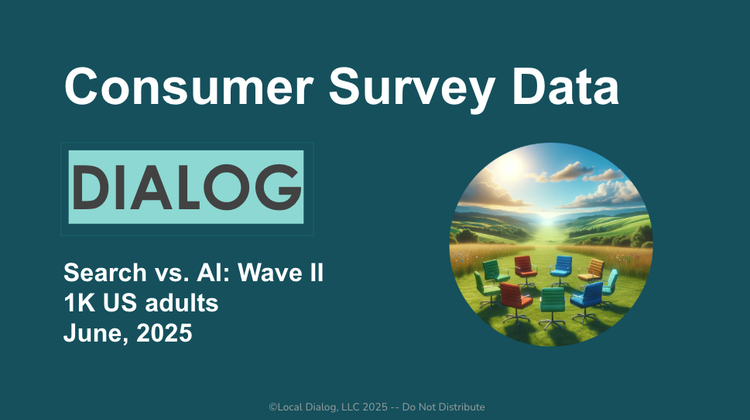AI Adoption: Where Does It Stand?

Few new technologies have generated as much hype as that surrounding generative AI. But it would seem to be more justified in this case than, say, voice search, bitcoin/blockchain or AR/VR – to name a few recent examples.
While some of the claims out there are certainly hyperbolic and aggressive, we believe generative AI is a transformational development with significant long-term implications for almost everyone in the economy, from consumers and small businesses, to software and technology companies to major enterprises.
For this reason, in our onboarding deck, we have the following slide:
Having said all that, it's pretty rare that real-world adoption matches PR-driven analyst projections. Things tend to happen more slowly than expected at the start, but accelerate over time. That idea calls to mind the Bill Gates (or Roy Amara) quote, "Most people overestimate what they can do in one year and underestimate what they can do in ten years."
AI's capacity to analyze data, produce content, images, video and music are already pretty astonishing. Imagine what will be possible in a decade – if the machines haven’t completely taken over by then.
But what about the state of AI adoption today? Where does that stand? Does adoption match the hype? The survey data are a little all over the place and paint a mixed picture. Let’s take a look.
Census Bureau Findings: 5%
The US Census Bureau this year published data on AI adoption, representing the responses of more than 1 million US businesses, aggregated from "six collection periods." Data collection began in September 2023 and carried into 2024. The primary question was, "In the last two weeks, did this business use Artificial Intelligence (AI) in producing goods or services?" The national average for those saying "yes" was 5%, while 84% said "no" and roughly 11% said "don't know."
Segmenting by headcount, the two groups with the highest rates of adoption were the largest and the smallest businesses in the survey – those with 1 - 4 employees (5.5%) and those with more than 250 employees (7.2%). When asked about future AI use, the numbers went up to 6.5% overall: 7% for those in 1 - 4 headcount group, and to 11% for firms with more than 250 employees.
These numbers are considerably lower than other surveys in the market, including ours and the sample was much larger than other surveys. It's possible that the largest enterprises, where adoption might be higher, are not well represented in the Census Bureau data.
Enterprise Challenges & Barriers
One potential reason for the low adoption numbers above is a surprisingly large set of implementation challenges and barriers, especially for larger mid-market and enterprise-scale companies:
- Lack of a clear vision of how to use AI
- Uncertainty about benefits and use cases
- Job displacement concerns
- Accuracy and transparency worries
- Lack of internal AI expertise and data challenges
- Business culture and process issues
- Cost and resource allocation questions
- Security, privacy and ethical concerns
- Legal and potential regulatory questions
That's only a partial list.
Mixed Adoption Numbers
McKinsey says (Q1 2024) its data show 65% adoption for enterprises globally: "respondents report that their organizations are regularly using gen AI, nearly double the percentage from our previous survey just ten months ago." This is almost impossible to reconcile with the Census Bureau data and it's probably unrepresentative of the market generally. It may also be more aspirational or a statement of future intention by the respondents than a true reflection of current AI deployments.
In stark contrast to the McKinsey findings, Lucidworks' 2024 survey of 2,500 global businesses, which didn't offer an overall adoption percentage, observed that “Only 25% of planned generative AI investments have been fully implemented so far.” The survey also found a reduction of intended future spending on AI because of uncertain benefits. Another Q1 2024 survey from IBM found that "about 42% of enterprise-scale companies surveyed (> 1,000 employees) report having actively deployed AI in their business."
All this raises the question of what constitutes "regularly using" or "actively deployed"? And there's a potentially important distinction between corporate AI deployments and informal use of AI tools by workers in those same organizations.
Workers Not Waiting for Bosses
Pew Research discovered in March of this year, for example, that about 20% of surveyed adults said that they had used ChatGPT specifically for work. That number went up to 31% for people under 30. And in May, Microsoft released results of a "global knowledge worker" survey of 31,000 people across 31 countries. The company reported that "75% of global knowledge workers using it ... bringing their own AI to work."
So there may be some conflation of individual use of AI at work and official rollouts.
There are additional reports, from Deloitte, PwC and others that claim to benchmark enterprise AI adoption. Those numbers vary too. In reality, there's uneven AI adoption, with evidence that some large enterprises and selected verticals are ahead of others.
One also gets the sense that what people are calling "adoption" varies. As mentioned, there are lots of challenges and organizational roadblocks to full deployment in the enterprise. And in its absence many employees are "privately" using ChatGPT and other tools to help with work-related tasks.
In many of these organizations, workers may be ahead of management when it comes to integrating AI into daily operations.
Small Business Uptake
Local businesses don't suffer the same hesitation, bureaucracy and organizational hurdles as large enterprises. There are no corporate boards, fewer management layers, less process and no pesky legal departments to appease. Many small business owners can simply "adopt" a tool and start using it immediately. This is what we found in our local business interviews.
It's thus our belief that small businesses, in some fundamental ways, may be ahead enterprises in embracing and using AI. While any individual survey must be taken with some caution, our data shows that 60% of local businesses (1 - 499 employees) are actively using or testing AI.
Again, that begs the question of "active use," which our survey did not explore. But our interviews and discussions with business owners suggest that many of them have incorporated AI into regular use and that there are an array of SMB use cases already.

In our survey, the group that had the highest percentage of active users were businesses with 51 - 100 employees. Roughly 45% of them were using or testing. The next highest (32.5%) was the 11 - 50 headcount category. Beyond this, younger operators/owners were more likely to be knowledgeable about and actively using AI tools than older business operators – as you might expect.
Overall, the large majority of respondents (77%) are moderately or highly positive about the potential impact of AI on their industries.
A 2024 AI survey from Thryv found 39% of mostly smaller businesses say they're using AI today (no distinction between using and testing). The top two reasons for adoption were saving time and saving money. However, saving money was the biggest motivator among those who planned to use AI but hadn't adopted it yet.
Mostly ChatGPT Right Now
According to Microsoft-sponsored 2024 research, "37% [of SMBs] are knowingly using AI." The report points out, however, that businesses may over or under-report using AI because of confusion. "One of every three [businesses] mistake basic automation for generative and conversational AI ... [and] a third of those who believe they don’t use AI are using it unknowingly," the analysis explains.
In both our survey and the Thryv survey, what "adopting" AI means as a practical matter is mostly using ChatGPT for a variety of tasks and functions. In both surveys, ChatGPT and Google Bard/Gemini were one and two respectively – with ChatGPT usage running about 1.7X to Google in the Dialog survey and 2X in the Thryv survey.
Perhaps the most interesting finding of the Thryv survey is that just under half of current small business AI users (and the AI-curious) would prefer to use an AI tool over hiring a new human employee.
Agencies Are the Winners
A recently released survey from Forrester found that 91% of US ad agencies are now using (61%) or "exploring" AI (30%). This easily makes agencies the fastest-adopting segment in the data we've reviewed.
Larger agencies (200+ employees) had higher adoption rates (78%) than smaller agencies with fewer than 50 employees (53%). Among the benefits and uses cases identified in the report were:
- Improved productivity generally
- Creative "ideation" and brainstorming
- Generating assets for dynamic digital ad creative (aspirational)
- Summarizing audience research and insights
- Summarizing campaign performance
- Creating buyer profiles and personas
- Competitive research
- Summarizing calls, meetings and presentations
As with larger enterprises there are a number of challenges and risks for agencies, including legal (IP ownership, copyright), data security/privacy, accuracy of the output and concerns about lack of AI expertise among employees.
Another agency concern, not reflected in the Forrester report, is how AI integration may impact agency pricing and business models.
A 2023 agency survey from Vendasta (Agency Insights Report) showed that a majority of agencies are somewhere along an AI adoption curve, with 69% being "very new to AI" at the time. And Duda's 2024 Outlook for Digital Agency Leaders report (global sample, n=200) found that 100% of respondents were using AI in some capacity as of December 2023. The seven most common uses were:
- Content Strategy - 40%
- Personalization - 35%
- Design, Illustration and Image Creation - 32%
- Editing Content - 29%
- Writing Content - 26%
- SEO - 26%
- Research - 25%
Early results from Dialog's new agency survey (not yet complete) indicate more than 90% of respondents are actively using or testing AI. As with the small business survey findings, ChatGPT is by far the most commonly used AI tool.
More than half of agencies in our survey say they're using AI for client-facing work. And the biggest perceived benefit is increased productivity. We'll have more to discuss about our findings in the coming weeks.
Reconciling the Numbers
So what are we to make of all these findings? The numbers, especially the enterprise survey data, don't fully align – especially the Census Bureau Data. But if you step back the majority of the data are directionally similar and point to rising AI adoption rates.
It's clear from the previous discussion that agencies have been the fastest group to incorporate AI into their operations and client work. And the largest group in the Dialog agency survey has been using AI for more than a year already.
The story with enterprises is more complex. They clearly recognize the opportunity and potential benefits of AI, but face numerous legal, organizational and practical challenges in incorporating it into daily workflows. Indeed, there may ultimately need to be internal reorganizations, to varying degrees, to truly "leverage" AI. But that's a topic for another discussion.
Smaller, local businesses have embraced AI conceptually and many are using it regularly, though their understanding of all the potential applications is more limited – with some exceptions (see, e.g., here, here). Many are finding their way organically – just trying stuff.
AI adoption will happen across the board. It will be staggered and uneven – but it is happening in firms large and small. And unlike many other technology "trends" before it, AI is going to have a significant impact on all of us.





